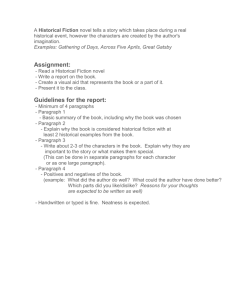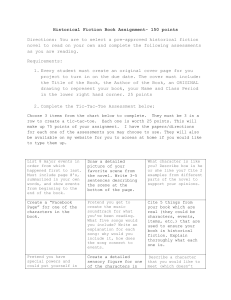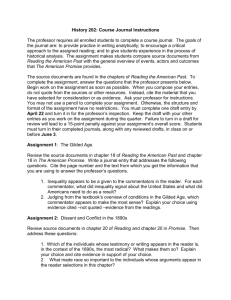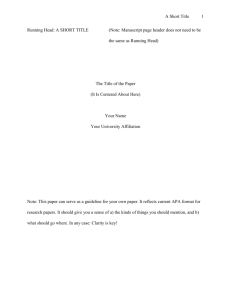Summer Assignment for 6th and 7th Grade Directions: Choose two
advertisement
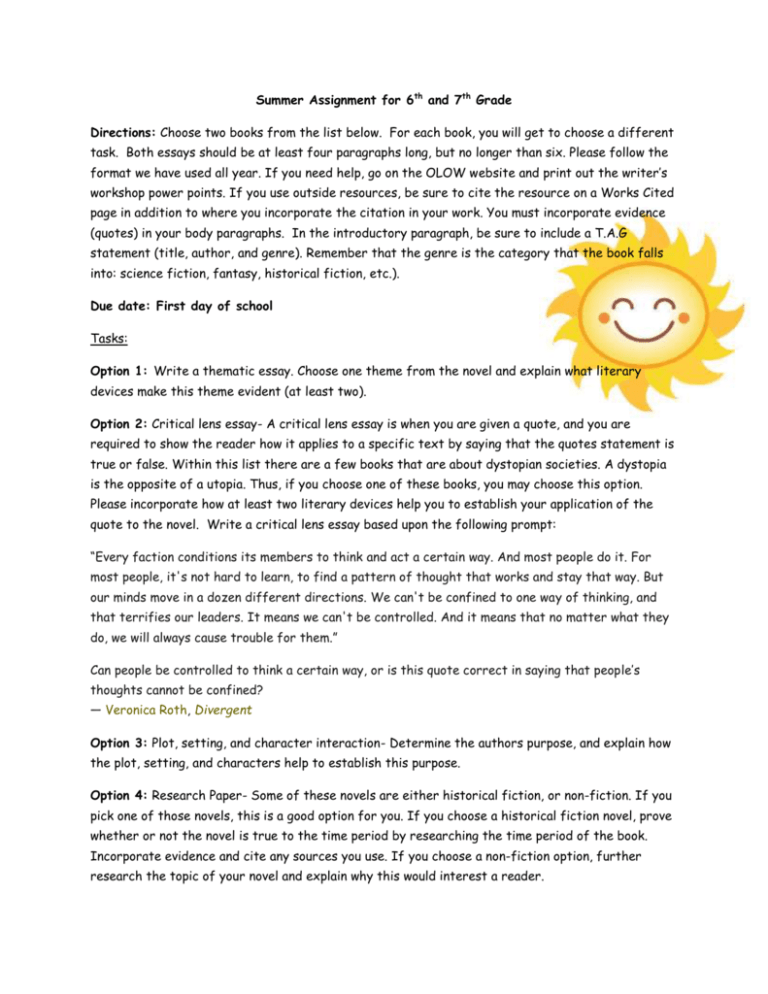
Summer Assignment for 6th and 7th Grade Directions: Choose two books from the list below. For each book, you will get to choose a different task. Both essays should be at least four paragraphs long, but no longer than six. Please follow the format we have used all year. If you need help, go on the OLOW website and print out the writer’s workshop power points. If you use outside resources, be sure to cite the resource on a Works Cited page in addition to where you incorporate the citation in your work. You must incorporate evidence (quotes) in your body paragraphs. In the introductory paragraph, be sure to include a T.A.G statement (title, author, and genre). Remember that the genre is the category that the book falls into: science fiction, fantasy, historical fiction, etc.). Due date: First day of school Tasks: Option 1: Write a thematic essay. Choose one theme from the novel and explain what literary devices make this theme evident (at least two). Option 2: Critical lens essay- A critical lens essay is when you are given a quote, and you are required to show the reader how it applies to a specific text by saying that the quotes statement is true or false. Within this list there are a few books that are about dystopian societies. A dystopia is the opposite of a utopia. Thus, if you choose one of these books, you may choose this option. Please incorporate how at least two literary devices help you to establish your application of the quote to the novel. Write a critical lens essay based upon the following prompt: “Every faction conditions its members to think and act a certain way. And most people do it. For most people, it's not hard to learn, to find a pattern of thought that works and stay that way. But our minds move in a dozen different directions. We can't be confined to one way of thinking, and that terrifies our leaders. It means we can't be controlled. And it means that no matter what they do, we will always cause trouble for them.” Can people be controlled to think a certain way, or is this quote correct in saying that people’s thoughts cannot be confined? ― Veronica Roth, Divergent Option 3: Plot, setting, and character interaction- Determine the authors purpose, and explain how the plot, setting, and characters help to establish this purpose. Option 4: Research Paper- Some of these novels are either historical fiction, or non-fiction. If you pick one of those novels, this is a good option for you. If you choose a historical fiction novel, prove whether or not the novel is true to the time period by researching the time period of the book. Incorporate evidence and cite any sources you use. If you choose a non-fiction option, further research the topic of your novel and explain why this would interest a reader. Book list: James Dashner. The Maze Runner. Chris Bradford. The Way of the Warrior. Rebecca Stead. When You Reach Me. Jasper Fforde. The Last Dragonslayer. John Flanagan. The Outcasts. S. J. Kincaid. Insignia. Marie Lu. Legend. Mike Lupica. Travel Team. Marissa Meyer. Cinder. Mark Twain. The Adventures Of Tom Sawyer. Dan Wells. Partials. Richard Yancey. The 5th Wave . Orson Scott Card. Ender’s Game Rodman Philbrick. Freak the Mighty Nancy Farmer-A Girl Named Disaster Carl Hiaasen. Hoot Jacqueline Woodson. Hush Mal Peet. Keeper Katherine Paterson. Lyddie James Lincoln Collier and Christopher Collier. My Brother Sam is Dead Cynthia Voigt. The Runner Christopher Paul Curtis. Bud, Not Buddy Laurence Yep. Dragonwings Jean Craighead George. Frightful’s Mountain Linda Sue Park. A Long Walk to Water Writing Tips Use a proper format: Times New Roman, size twelve, double spaced, indent when you start a new paragraph (use the tab space). Use a proper heading: Name Date Teacher Subject Stay formal: never write ‘I’ in your essay. Even though you are writing it, whenever you feel like you want to incorporate yourself, try to replace ‘I’ with ‘the reader.’ Always determine your purpose before you begin to write. Ask yourself, who is going to be reading this, and what do I want them to learn? Look back at the task and determine how you want to organize your paper. Before you start writing, brainstorm! After brainstorming begin your rough draft. Remember that writing is a process, so this is the first step! After you finish your first draft, take a break. Give yourself a day or two away from it. That way, when you go back to edit and revise, you have a fresh mind. While editing your work, look for organization, the standard English conventions (grammar usage), syntax (sentence structure), and your details. IICE and TIICE your evidence. (Introduce your evidence, Insert the actual quote, Cite where you found the quote, and Explain why it applies to your thesis). When inserting a second or third piece of evidence into the same paragraph, TIICE your quotes. (Transition, Introduce, Insert, Cite, Explain) Always remember to start your body paragraphs with a topic sentence that helps to prove your thesis, and end it with a concluding sentence that restates your topic sentence. All essays must have an introduction paragraph, and a conclusion paragraph. You thesis should be found in the introduction paragraph. This claim will help the reader to understand what your purpose is. Have a friend or family member read your work. It is always helpful to have someone else, who is unfamiliar with the task, read your writing! Before submitting these assignments at the beginning of the school year, ask yourself: Am I proud of my work?

